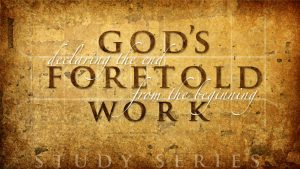What do you make of the fact the week the British mandate ended and Israel became a nation, May 14 1948, the Torah portion reading included Amos 9?
I think it was a token that the Lord is gracious to encourage those who had so lately endured so much that the promise of return is faithful and running on schedule. This is the Hatikvah [“The Hope”]. But this is not the only return. Just as the exile to Babylon was not the last exile, and the return not the last return. The present return is subject to further dispersion, as the far greater number of return prophecies speak of a final and complete return to follow an unequaled trouble that ends with Israel’s national repentance and the judgment of all their enemies.
It is very important that we not neglect the larger context of Amos 9, lest many be deceived and unprepared for what lies still ahead. There is an order to the return that is often overlooked. We must remind ourselves when Amos penned these words. It was before the fall of the northern kingdom. Since then, there has been, not one but two returns to the Land. The return from Babylon proved far short of the promise as described in Amos 9, leaving Israel vulnerable to further judgment and exile. It is the same with the present return.
Since Amos 9:15 is often cited as proof that the people of Israel will “never again” be uprooted out of their Land to which they have so lately returned, let us review the context:
“On that day I will raise up The tabernacle of David, which has fallen down, And repair its damages; I will raise up its ruins, And rebuild it as in the days of old; That they may possess the remnant of Edom, And all the Gentiles who are called by My name,” says the Lord who does this thing. “Behold, the days are coming,” says the Lord, “When the plowman shall overtake the reaper, And the treader of grapes him who sows seed; The mountains shall drip with sweet wine, And all the hills shall flow with it. I will bring back the captives of My people Israel; They shall build the waste cities and inhabit them; They shall plant vineyards and drink wine from them; They shall also make gardens and eat fruit from them. 15 I will plant them in ‘their’ Land, And they shall NEVER AGAIN be pulled up out of their Land, which I have given THEM, says the Lord your God” (Amos 9:11-15, NKJV, NIV).
This is descriptive of the arrival of the Davidic kingdom. So long as Israel remains threatened surrounding enemies, the promise of the Davidic covenant has yet to be fulfilled (2Sam 7:10) The return in view is NOT the pre-tribulational return, whether past or present, but the post-tribulational return that follows the final judgment of Israel’s enemies. This full and complete return to everlasting peace and secure continuance in the Land is most typically the context of the far greater number of return prophecies.
“And I will make a resting-place for my people Israel, planting them there, so that they may be living in the place which is theirs, and NEVER AGAIN be moved; and NEVER AGAIN will they be troubled by evil men as they were at the first” (2 Sam 7:10, BBE)
Jeremiah appears surprised to see that the return from Babylon would not at once fulfill all the glorious conditions described in Amos 9. Jeremiah’s vision of Jacob’s trouble expresses the popular assumption that the promised kingdom of peace would immediately follow the predicted judgment on Babylon (Jer 25:12-15; 29:10-14). Instead, he is astonished to see ‘the day’ that is like no other.
“For, lo, the days come, saith the Lord, that I will bring again the captivity of my people Israel and Judah, saith the Lord: and I will cause them to return to the land that I gave to their fathers, and they shall possess it. And these are the words that the Lord spake concerning Israel and concerning Judah. For thus saith the Lord; We have heard a voice of trembling, of fear, and not of peace. Ask ye now, and see whether a man doth travail with child? wherefore do I see every man with his hands on his loins, as a woman in travail, and all faces are turned into paleness? Alas! for that day is great, so that none is like it: it is even the time of Jacob’s trouble; but he shall be saved out of it” (Jer 30:3-7).
Now consider. Jeremiah had predicted that Israel’s return from Babylon would not come until after the predicted seventy years of exile (Jer 29:10-14). So when Jeremiah speaks of ‘the time of Jacob’s trouble’, what ‘day’ could he have in mind? It can only be the everywhere mentioned day of the Lord, because only then is the final oppressor destroyed and peace in the Land secure forever under the messianic king, as described in Jer 30:8-10, 16:22, and all throughout the so-called, ‘book of consolation (Jer chs 30-33).
This is our exegetical choice. Do we interpret “that day” of Jacob’s trouble as an event lying only in the past, only in the future, or with some, both past and future? To be sure, there have been visitations of divine judgment that presaged the day of the Lord, and some would argue for multiple ‘days’ of the Lord, but there is only one ‘day of the Lord’ that ends in the messianic kingdom that so clearly follows immediately after the time of Jacob’s trouble (Jer 30:8-10, 16-22 with Dan 12:1-2; Eze 39:8, 22, 28-29 et al).
Even on the basis of Jeremiah’s limited perspective, the destruction of 587 B.C. must be ruled out as constituting ‘that day’, because this was not followed by the abiding peace and everlasting righteousness described in Jer 30, and reiterated all throughout the ‘book of consolation’ (Jer 30-33), but by seventy years of captivity in a foreign land. And by no stretch of the imagination can the term, ‘that day’ be made to stand for the entirety of the exile. Furthermore, Jeremiah would have been aware of Isaiah’s prophecy that associated the ‘day of the Lord’ with Babylon’s destruction at the hands of the Persians (Isa 13:1-19; 44:28; 45:1).
It is noteworthy that the conditions that are described as following upon Babylon’s fall to the Persians in both Isaiah’s and Jeremiah’s prophecy (Isa 13:17-19; Jer 29:12-14; 50:9; 51:28-29 ) stand in marked contrast to the prophets’ vivid descriptions of the messianic era. Even before Daniel’s prophecy of a continuous succession of world empires, Isaiah and Jeremiah sees beyond Persia’s overthrow of Babylon, which proved only a type of a yet greater and more ultimate day of the Lord still to come. This is further evidence that Jeremiah sees this climactic, and ultimately transitional day somewhere quite beyond the liberation that Isaiah had associated with the destruction of Babylon at the hands of the Medes and Persians under Cyrus (Isa 13:16-19; 48:28; 45:1-5 with Jer 25:12-14, 25; 51:11, 28).
The prophets show an implicit understanding of typology. Consider. As much as Isaiah knew that Babylon would be succeeded by Persia, and that Cyrus was only a figure of the liberation that could only come through the Messiah Redeemer from David’s line (Isa 9:6-7; 11:1-5). And as much as both Isaiah and Jeremiah knew that neither Assyria nor Babylon was the last of the great world empires to stand before the kingdom age, but that both stood as figures of a more ultimate oppressor to be destroyed by none other than the Messiah (Isa 9:4, 14; 10:5, 17, 20-27; 11:4-5; 14:3-4, 24-27; 30:31; 31:8; Jer 30:8, 14; see especially the Septuagint translation of Isa 11:4 as cited by Paul in 2Thess 2:8), it becomes evident that not only the Spirit who inspired them, but the prophets themselves were quite aware of a recurrent pattern of partial fulfillment that prefigured a more ultimate eschatological crisis that would usher in the rod iron rule of David’s greater son and Lord (Ps 2; 110). This is something to ponder.
Consider too that in both Isaiah and Ezekiel, the day of the Lord is depicted as coming upon a nation that has only recently returned to the Land after ‘many generations’ of desolation (Isa 61:4; 63:18; Eze 38:8). This return would not be to the permanent peace of the messianic era but to continued threat from their enemies at a time when the Land has become prosperous (Eze 38:12-13), with its beauty likened to Eden (Joel 2:3). Context will show that these prophecies are not speaking of millennial conditions, as in Eze 36:35, but of the state of the Land that exists just prior to the day of the Lord, the day that will be ‘like no other’ (compare Joel 2:1-3; Isa 13:5-8; Jer 30:5-7).
Even if it should be questioned whether Jeremiah sees this unequaled time of trouble as taking place in the Land AFTER the return of Jer 30:3, it cannot be disputed where Daniel puts the time of unequaled trouble, as he has obviously contemplated Jeremiah’s prophecy (Dan 9:2) and will appropriate the language of Jeremiah’s prophecy of Jacob’s trouble to describe the final tribulation (compare Jer 30:7 with Dan 12:1). Clearly, Daniel places the unequaled trouble at ‘the end of days’ when his people will be delivered and the righteous raised to everlasting life at this time (Dan 12:1-2, 14).
Very clearly, in both Daniel and Revelation, the unequaled tribulation is equated with the last half of the final seven years that begins with Michael’s heavenly victory over Satan and the placing of the abomination in the temple (Dan 7:25; 9:27; 11:31; 12:1, 7, 11 with Mt 24:15, 21; 2Thes 2:4; Rev 11:2; 12:6, 7-14; 13:5). Furthermore, the later prophets of the return (Haggai, Zechariah, Malachi) show clearly that the return from Babylon by Persian decree was only a precursor to a much greater and more complete return that takes place AFTER the still coming day of the Lord (Zech 8:7-8; 10:6-10; 14:1; Hag 2:6-7, 22; Mal 4:5).
Therefore, before we ‘over-conclude’ for the present return (though indeed a sign of the first magnitude), we must not forget that until Israel has attained to the ‘everlasting righteousness’ of the New Covenant (Isa 45:17; Jer 31:31-34; 32:40; Dan 9:24), the great tribulation that concludes the age is manifestly still future.
What Jeremiah and the prophets understood of the return from Babylon is no less true of the modern return. As with the return from Babylon, the Jews are home again, but they’re not yet ‘home free’. Remarkably, and wondrously, the Jews are back in the Land. The return from Babylon was after seventy years, which is only one generation, but this return will be after “the desolation of many generations” (Isa 61:4). That is a significant distinction! Nevertheless, a final suffering at the hand of a ‘cruel one’ (Jer 30:14) is yet ‘determined’ (Dan 9:24, 27; 11:36) to, at some point, follow the present return.
In notable contrast to both of these returns, the return that will follow the day of the Lord will end the diaspora forever, because from that return, not one will be left behind (Eze 39:28-29). Until ‘that day’, whether in the Land or out of the Land, Israel remains under the abiding threat of covenant judgment. Only after a final tribulation of unequaled severity (Jer 30:7; Dan 12:1; Mt 24:21) will all Israel be saved and justified with an everlasting salvation (Isa 45:17, 25). “From that day and forward” (Eze 39:22), all (and not only a remnant) will know Him, so that there is no more need for evangelism among the Jews and their children again forever (Isa 54:13; 59:21; 60:21; 66:22; Jer 31:34 et al). This is astounding! No wonder interpreters cannot conceive of such an uniform salvation among the Jews ever happening here, on this earth.
Regardless of how clearly the former prophets saw beyond the destruction of Babylon, Daniel and the later prophets are very clear that the sufferings of the Jews does not end with the return from Babylon. Daniel sees the rise and fall of many kingdoms, some fierce persecutors of his people. It is this state of affairs that is expected to continue until “the coming in of the ‘everlasting righteousness'” (Jer 32:40; Dan 9:24). Although Daniel does not use the specific phrase, ‘the day of the Lord’, it cannot be mistaken that his seventy week prophecy ends just there, with Israel’s ultimate deliverance and the resurrection (Dan 12:1-2).
On ‘that day’, when the great trumpet will sound (Isa 27:12-13), the penitent survivors of Israel begin their trek back home, this time over the great waterways that have been lately dried up, evidently by the events presaging Armageddon (compare Isa 11:15-16; 27:12-13; Zech 10:10-11; Rev 16:12). The penitent survivors of Israel will be assisted by willing gentiles that have also survived (Isa 14:2: 49:22; 60:9; 66:20; Zech 8:23). This is the far more complete and final return from which no Jewish survivor will be left behind in the nations (Eze 39:28-29).
The prophets well knew that no revival or return could be sufficient to secure abiding peace in the Land that did not attain to the ‘everlasting righteousness’ from which they will “never again depart” (Isa 59:21; Jer 32:40). They understood that until ‘all Israel’ (and not only a remnant) attains to THIS righteousness, the discipline of the covenant continues and further desolations are determined (Dan 9:26; 11:31; Mt 24:15-16, 21: Rev 11:2).
That this well established axiom of biblical eschatology is not more commonly understood and taught is as strange as it is haunting. Its oversight or denial leaves the Jewish people open to great deception, as also the shattering of the faith of many who join them in saying, ‘this will not come to us’ (Isa 28:14-15; Amos 9:10; 1Thes 5:3).
This raises the question of the church’s job description. If the church is, as Paul calls her, “the pillar and ground of truth,” where is the clear voice of warning that is in agreement with these prophets of return? Who will tell them that the modern return has no more guarantee of permanence than the return from Babylon?
Whereas we agree that the remarkable repatriation of the Land is in accordance with the irrevocable promise made to the fathers (Jer 30:3), it is the prophets of Israel who insist that there can be no final and secure inheritance of the Land that is not based on the everlasting righteousness that has come to full light in the gospel. It is the church’s task to not only speak of this kind of righteousness but to demonstrate it in a way that makes the contrast compelling, thus moving some of them to emulation.
Jewish right to the Land is unconditional, but their ability to keep it is clearly conditioned upon covenant obedience. It is always ‘their’ land, even in their blindness and disobedience. The divine grant of the Land was never based on their righteousness (see Deut 9:4-6). God holds the nations accountable to understand this. This is seen in the ferocity of the judgements that God has decreed on the nations that presumptuously dismiss and disregard the ‘everlasting covenant’ that includes the Land grant (Ps 105:8-11). The divine threat on those who curse Israel in their hearts is not based on Israel’s righteousness but their election. This is evident as the very nations that are brought down in judgment of a disobedient Israel become the objects of divine wrath for their disregard of the covenant. But secure peace in the Land depends on the righteousness that is God’s alone, the ‘everlasting righteousness’, as only this righteousness can make true covenant keeping possible by the power of the Spirit.
Just a few thoughts your question sparked. Reggie




